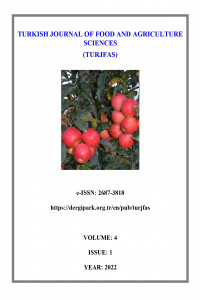Review
Research Articles
Issue Editorial Board







 Web
Web
Professor Mohammad Shafiur Rahman is the author/co-author of over 450 technical articles including more than 160 journal papers and 15 books. He is the author of the internationally acclaimed and award-wining Food Properties Handbook, and editor of the popular Handbook of Food Preservation published by CRC Press, Florida. First editions received the bestseller recognition and the third edition is now released. First edition was translated into Spanish. He was invited to serve as one of the Associate Editors for the Handbook of Food Science, Engineering and Technology, and one of the Editors for the Handbook of Food and Bioprocess Modeling Techniques published by CRC Press, FL. He has initiated the International Journal of Food Properties and serving as the founding Editor-in-Chief for more than 25 years, and serving in the editorial boards of 10 international journals and book series. He is serving as an Editor-in-Chief for the Journal of Agricultural and Marine Sciences (CAMS), published by Sultan Qaboos University, Oman. In 1998, he has been invited and continued to serve as a Food Science Adviser for the International Foundation for Science, Sweden. He was invited as keynote/plenary speaker more than 15 international conferences in the food science and engineering area. He received the HortResearch Chairman's Award, BRAP Award, CAMS Outstanding Researcher Award 2003, SQU Distinction in Research Award 2008, Oman National Award 2020. In 2008, Professor Rahman has ranked among the top five Leading Scientists and Engineers of 57 OIC Member Countries in the Agroscience Discipline. In 2020, he was recognized among World Top 2% influential scholars around the World (ranked 107 among 48,454 food science researchers), published by Stanford University, USA.


Aim & Scope
Turkish Journal of Food and Agriculture Sciences (TURJFAS) is an unbiased, Open Access, and independent international double-blinded peer-review journal.
TURJFAS publishes academic studies related to food and agriculture sciences.
Academic studies written in English are published in the form of review articles,
short reviews, research papers, and research and technical notes.
TURJFAS publishes Biannually (June and December).
A Digital Object Identifier (DOI) number is assigned for each article accepted to be published in TURJFAS.
All submissions are screened by plagiarism detection software (below 20% via IThenticate)
The scope of the journal includes agricultural economics, animal science, biosystems engineering, field crops, horticulture, plant physiology, postharvest biology and technology, ornamental, biochemistry, plant protection, soil science and plant nutrition from agriculture sciences subjects, and food technology, food composition, food industry, food biochemistry, food processing, from food sciences subjects. Papers featuring animal trials are outside the scope of the journal and will not be considered for publication.
Research may be published as Original Research Articles, Short Communications, Critical Reviews, technical note, according to subject matter and presentation. Editor assignment will be made by the Managing Editor, but author guidance is appreciated. Only original papers will be considered. Manuscripts are submitted for review with the understanding that the same work has not been copyrighted, published, or submitted for publication elsewhere.
Author Guidelines
SAMPLE TEMPLATE: https://dergipark.org.tr/tr/download/journal-file/22272
PREPARATION OF MANUSCRIPT
Manuscript submitted to the journal should be prepared on A4 size paper in 12 point, Times New Roman font, leaving 2,5 cm blank spaces all four margins of each page. Please ensure the text of your paper is double-spaced and has consecutive line numbering - this is an essential peer review requirement. Each page should be numbered.
Manuscript Structure
There are no strict formatting requirements but all manuscripts must contain the essential elements needed to convey your manuscript, for example Tittle, Abstract, Keywords, Introduction, Materials and Methods, Results, Conclusions, Artwork and Tables with Captions.
Title: The title of manuscript should contain short and illustrative not exceeding twenty words.
Abstract: A concise and factual abstract is required. The abstract should state briefly the purpose of the research, the principal results and major conclusions. An abstract is often presented separately from the article, so it must be able to stand alone. For this reason, References should be avoided, but if essential, then cite the author(s) and year(s). Also, non-standard or uncommon abbreviations should be avoided, but if essential they must be defined at their first mention in the abstract itself.
Keywords: Immediately after the abstract, this section should be contain maximum of 6 keywords in alphabetical order.
Subdivision-numbered sections
Divide your article into clearly defined and numbered sections. Subsections should be numbered 1.1 (then 1.1.1, 1.1.2, ...), 1.2, etc. (the abstract is not included in section numbering). Use this numbering also for internal cross-referencing: do not just refer to 'the text'. Any subsection may be given a brief heading. Each heading should appear on its own separate line.
Introduction
State the objectives of the work and provide an adequate background, avoiding a detailed literature survey or a summary of the results.
Material(s) and methods
Provide sufficient details to allow the work to be reproduced by an independent researcher. Methods that are already published should be summarized, and indicated by a reference. If quoting directly from a previously published method, use quotation marks and also cite the source. Any modifications to existing methods should also be described.
Results
Results should be clear and concise.
Discussion
This should explore the significance of the results of the work, not repeat them. Avoid extensive citations and discussion of published literature. Results and Discussion should be two separate sections.
Conclusions
The main conclusions of the study may be presented in a short Conclusions section, which may stand alone or form a subsection of a Discussion or Results and Discussion section.
References
Where applicable, author(s) name(s), journal title/book title, chapter title/article title, year of publication, journal name, volume number/book chapter and the article number or pagination must be present. Use of DOI is highly encouraged. Note that missing data will be highlighted at proof stage for the author to correct. If you do wish to format the references yourself, they should be arranged according to the following examples:
Text:
All citations in the text should refer to:
1. Single author: the author's name (without initials, unless there is ambiguity) and the year of publication;
2. Two authors: both authors' names and the year of publication;
3. Three or more authors: first author's name followed by 'et al.' and the year of publication.
Citations may be made directly (or parenthetically). Groups of references can be listed either first alphabetically, then chronologically, or vice versa.
Examples: as demonstrated (Sengül, 2015; Demir, 2017), (Bilge and Yildiz, 2017; Yilmaz et al., 2018) … Thomson (2016) reported as ….. Ozturk and Bulut (2018) have recently repoted …… Hassanpour et al. (2010) have recently shown …….
List:
References should be arranged first alphabetically and then further sorted chronologically if necessary. More than one reference from the same author(s) in the same year must be identified by the letters 'a', 'b', 'c', etc., placed after the year of publication.
Examples: (According to: APA)
Reference to a journal publication:
Aglar, E., Ozturk, B., Guler, S.K., Karakaya, O., Uzun, S., & Saracoglu, O. (2017). Effect of modified atmosphere packaging and ‘Parka’ treatments on fruit quality characteristics of sweet cherry fruits (Prunus avium L. ‘0900 Ziraat’) during cold storage and shelf life. Sci. Hortic. 222, 162-168. https://doi.org/10.1016/j.scienta.2017.05.024
Reference to a book:
Hartmann, H. T., & Kester, D. E. (1975). Plant propagation: principles and practices. Prentice-Hall, New Jersey
Reference to a chapter in an edited book:
Brown, B., & Aaron, M. (2001). The politics of nature. The rise of modern genomics, 3rd edn. Wiley, New York, pp. 5-15
Proceedings
Balık, H. İ., Balık, S. K., Erdogan, V., Kafkas, S., Beyhan, N., Duyar, Ö., & Köse, Ç. (2017, August). Clonal selection in'Tombul'hazelnut: preliminary results. In IX International Congress on Hazelnut 1226 (pp. 53-58)
Reference to a website
FAO, 2019. Crops Production Quality. http://www.fao.org/home/en/ (accessed 15 April 2019).
Thesis
Karakaya, M. (2016). Effects of different treatments on fruit quality of Piraziz apple during cold storage. Master’s Thesis (or Doctoral Thesis), Ordu University, Institute of Science and Technology, Ordu.
Journal abbreviations source
Journal names should be abbreviated according to the List of Title Word Abbreviations
(https://images.webofknowledge.com/images/help/WOS/A_abrvjt.html).
Figures
Ensure that each illustration has a caption. A caption should comprise a brief title (not on the figure itself) and a description of the illustration. Keep text in the illustrations themselves to a minimum but explain all symbols and abbreviations used.
Tables
Please submit tables as editable text and not as images. Tables can be placed either next to the relevant text in the article, or on separate page(s) at the end. Number tables consecutively in accordance with their appearance in the text and place any table notes below the table body. Be sparing in the use of tables and ensure that the data presented in them do not duplicate results described elsewhere in the article. Please avoid using vertical rules and shading in table cells.
The statistical significance should be stated using P values (P<0.01) or ** symbols for which description should be given.
Units
SI unit systems should be used, / symbol should not be used in preparation of manuscript. (N or kg m-3 instead of kg or kg/m3).
Abbreviations and symbols
Abbreviations and symbols (if necessary) should be given in parentheses. Abbreviations should not be used in the manuscript title or subtitles. Formulas should be given as ‘equation’ and numbered in manuscript.
The author(s) visit the website and send e-mail to the journal for further information, any other request and look at the sample manuscript format.
Ethical Principles and Publication Policy
Price Policy
Turkish Journal of Food and Agriculture Sciences is an Open Access Journal, and does not charge any costs from authors, during article delivery, article-editorial processing, assessment and publication charges (page or color charges) in the printing stages.
All articles can be accessed as online, free of charge, on the journal web page.
Turkish Journal of Food and Agriculture Sciences is licensed under a Creative Commons Attribution-NonCommercial-NoDerivatives 4.0 International License.
Journal Abbreviation: Turk J Food Agric Sci


